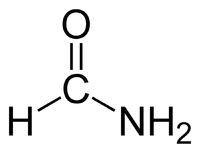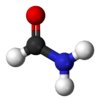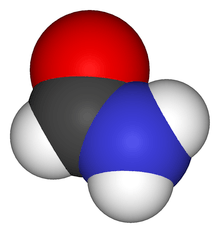Formamide
 | |||
| |||
| Names | |||
|---|---|---|---|
| Preferred IUPAC name
Formamide[1] | |||
| Systematic IUPAC name
Methanamide | |||
| Other names
Carbamaldehyde | |||
| Identifiers | |||
| 3D model (JSmol) |
|||
| ChEBI | |||
| ChemSpider | |||
| ECHA InfoCard | 100.000.766 | ||
| KEGG | |||
| PubChem CID |
|||
| |||
| |||
| Properties | |||
| CH3NO | |||
| Molar mass | 45.04 g/mol | ||
| Appearance | Colorless, oily liquid[2] | ||
| Density | 1.133 g/cm3 | ||
| Melting point | 2 to 3 °C (36 to 37 °F; 275 to 276 K) | ||
| Boiling point | 210 °C (410 °F; 483 K) | ||
| Miscible | |||
| Vapor pressure | 0.08 mmHg at 20 °C | ||
| Acidity (pKa) | 23.5 (in DMSO)[3] | ||
| -21.9·10−6 cm3/mol | |||
| Hazards | |||
| NFPA 704 | |||
| Flash point | 154 °C (309 °F; 427 K) (closed cup) | ||
| US health exposure limits (NIOSH): | |||
| PEL (Permissible) |
none[2] | ||
| REL (Recommended) |
TWA 10 ppm (15 mg/m3) [skin][2] | ||
| IDLH (Immediate danger) |
N.D.[2] | ||
| Related compounds | |||
| Related compounds |
Carbamic acid Dimethylformamide | ||
| Except where otherwise noted, data are given for materials in their standard state (at 25 °C [77 °F], 100 kPa). | |||
| | |||
| Infobox references | |||
Formamide, also known as methanamide, is an amide derived from formic acid. It is a clear liquid which is miscible with water and has an ammonia-like odor. It is chemical feedstock for the manufacture of sulfa drugs, other pharmaceuticals, herbicides, pesticides and the manufacture of hydrocyanic acid. It has been used as a softener for paper and fiber. It is a solvent for many ionic compounds. It has also been used as a solvent for resins and plasticizers.[4]
Formamide will begin to partially decompose into carbon monoxide and ammonia at 180 °C together with traces of hydrogen cyanide (HCN) and water. In the presence of solid acid catalysts, formamide yields HCN in high yield:[5]
- low temperature: HC(O)NH2 → CO + NH3
- high temperature, acid-catalyzed: HC(O)NH2 → HCN + H2O
Production
Historical production
In the past, formamide was produced by treating formic acid with ammonia, which produces ammonium formate, which in turn yield formamide upon heating:[6]
Formamide is also generated by aminolysis of ethyl formate:[7]
- HCOOCH2CH3 + NH3 → HCONH2 + CH3CH2OH
Modern production
The current industrial process for the manufacture of formamide involves either the carbonylation of ammonia:[4]
- CO + NH3 → HCONH2
An alternative two-stage process involves the aminolysis of methyl formate, which is formed from carbon monoxide and methanol:
- CO + CH3OH → HCOOCH3
- HCO2CH3 + NH3 → HC(O)NH2 + CH3OH
Applications
Formamide is used in the industrial production of hydrogen cyanide. It is also used as a solvent for processing various polymers such as polyacrylonitrile.[5]
Niche or laboratory applications
Formamide is a constituent of cryoprotectant vitrification mixtures used for cryopreservation of tissues and organs.
Formamide is also used as an RNA stabiliser in gel electrophoresis by deionizing RNA. In capillary electrophoresis, it is used for stabilizing (single) strands of denatured DNA.
Another use is to add it in sol-gel solutions in order to avoid cracking during sintering.
Formamide, in its pure state, has been used as an alternative solvent for the electrostatic self-assembly of polymer nanofilms.[8]
Formamide is used to prepare primary amines directly from ketones via their N-formyl derivatives, using the Leuckart reaction.
Hypothetical biochemistry
Formamide has also been proposed as an alternative solvent to water, perhaps with the ability to support life with alternative biochemistries to that currently found on Earth. It can be formed by the reaction of hydrogen cyanide and water, has a large dipole moment, and dissolves almost everything that will dissolve in water.[9]
RNA base creation
Formamide has been shown to create guanine at 130 °C in the presence of ultra violet light.[10]
Safety
Formamide is moderately irritating to the eyes, skin and mucous membranes.[11] Inhalation of large amounts of formamide vapor may require medical attention.[12][13] It is also a teratogen.[14] Formamide has been shown to exhibit hematoxicity in animals and is considered hazardous by prolonged exposure through inhalation, oral intake and dermal absorption.[15] Formamide should never be handled without proper safety attire including gloves and goggles.
References
- ↑ Nomenclature of Organic Chemistry : IUPAC Recommendations and Preferred Names 2013 (Blue Book). Cambridge: The Royal Society of Chemistry. 2014. p. 841. ISBN 978-0-85404-182-4. doi:10.1039/9781849733069-FP001.
The traditional name ‘formamide’ is retained for HCO-NH2 and is the preferred IUPAC name.
- 1 2 3 4 "NIOSH Pocket Guide to Chemical Hazards #0295". National Institute for Occupational Safety and Health (NIOSH).
- ↑ F. G. Bordwell; J. E. Bartmess; J. A. Hautala (1978). "Alkyl effects on equilibrium acidities of carbon acids in protic and dipolar aprotic media and the gas phase". J. Org. Chem. 43 (16): 3095–3101. doi:10.1021/jo00410a001.
- 1 2 Hohn, A. (1999). "Formamide". In Kroschwitz, Jacqueline I. Kirk-Othmer Concise Encylclopedia of Chemical Technology (4th ed.). New York: John Wiley & Sons, Inc. pp. 943–944. ISBN 978-0471419617.
- 1 2 Bipp, H.; Kieczka, H. (2005), "Formamides", Ullmann's Encyclopedia of Industrial Chemistry, Weinheim: Wiley-VCH, doi:10.1002/14356007.a12_001.pub2
- ↑ Lorin, M. (1864). "Preparation of Formamide by means of Formiates and Oxalates". The Chemical News and Journal of Physical Science. IX: 291. Retrieved 14 June 2014.
- ↑ Phelps, I.K.; Deming, C.D. (1908). "The Preparation of Formamide from Ethyl Formate and Ammonium Hydroxide". The Chemical News and Journal of Physical Science. XCVII: 86–87. Retrieved 14 June 2014.
- ↑ Vimal K. Kamineni; Yuri M. Lvov; Tabbetha A. Dobbins (2007). "Layer-by-Layer Nanoassembly of Polyelectrolytes Using Formamide as the Working Medium". Langmuir. 23 (14): 7423–7427. PMID 17536845. doi:10.1021/la700465n.
- ↑ Committee On The Limits Of Organic Life In Planetary Systems (2007). The Limits of Organic Life in Planetary Systems. Washington, DC: The National Academies Press. p. 74. ISBN 0-309-66906-5. Retrieved 2012-08-29.
- ↑ "Origin of Life: Adding UV Light Helps Form 'Missing G' of RNA Building Blocks". Science Daily. June 14, 2010.
- ↑ TOXNet Formamide HSDB: Formamide
- ↑ Warheit DB1, Kinney LA, Carakostas MC, Ross PE (1989). "Inhalation toxicity study of formamide in rats". Fundamental and Applied Toxicology. 13 (4): 702–713. PMID 2620791. doi:10.1093/toxsci/13.4.702.
- ↑ MSDS for formamide, hazard.com
- ↑ Lab use of formamide, University of Bath
- ↑ ECHA Formamide



